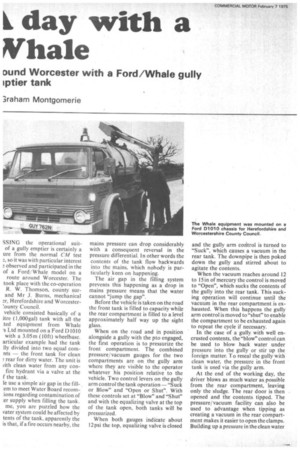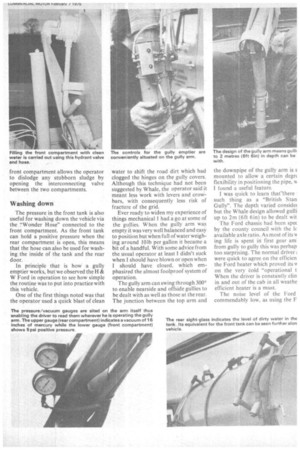k day with a Whale
Page 56

Page 57

Page 58

If you've noticed an error in this article please click here to report it so we can fix it.
Dund Worcester with a Ford/Whale gully iptier tank
3raham Montgomerie
SSING the operational suitof a gully emptier is certainly a ure from the normal CM test 2, so it was with particular interest observed and participated in the of a Ford/ Whale model on a route around Worcester. The took place with the co-operation R. W. Thomson, county surand Mr J. Burns, mechanical Herefordshire and Worcester(:)unty Council.
vehicle consisted basically of a itre (1,000gal) tank with all the ted equipment from Whale -s Ltd mounted on a Ford D1010 with a 3.05m (10ft) wheelbase. articular example had the tank lly divided into two equal cornnts — the front tank for clean rear for dirty water. The unit is rith clean water from any confire hydrant via a valve at the f the tank.
le use a simple air gap in the fillem to meet Water Board recomions regarding contamination of er supply when filling the tank. me, you are puzzled how the vater system could be affected by tents of the tank, apparently the is that, if a fire occurs nearby, the mains pressure can drop considerably with a consequent reversal in the pressure differential. In other words the contents of the tank flow backwards into the mains, which nobody is particularly keen on happening. The air gap in the filling system prevents this happening as a drop in mains pressure means that the water cannot "jump the gap".
Before the vehicle is taken on the road the front tank is filled to capacity while the rear compartment is filled to a level approximately half way up the sight glass.
When on the road and in position alongside a gully with the pto engaged, the first operation is to pressurize the front compartment. The combined pressure/ vacuum gauges for the two compartments are on the gully arm where they are visible to the operator whatever his position relative to the vehicle. Two control levers on the gully arm control the tank operation — "Suck or Blow" and "Open or Shut". With these controls set at "Blow" and "Shut" and with the equalizing valve at the top of the tank open, both tanks will be pressurized.
When both gauges indicate about 12 psi the top, equalizing valve is closed and the gully arm control is turned to "Suck", which causes a vacuum in the rear tank. The downpipe is then poked down the gully and stirred about to agitate the contents.
When the vacuum reaches around 12 to 15 in of mercury the control is moved to "Open", which sucks the contents of the gully into the rear tank. This sucking operation will continue until the vacuum in the rear compartment is exhausted. When this happens the gully arm control is moved to "shut" to enable the compartment to be exhausted again to repeat the cycle if necessary.
In the case of a gully with well encrusted contents, the"blow" control can be used to blow back water under pressure into the gully or stir up the foreign matter. To reseal the gully with clean water, the pressure in the front tank is used via the gully arm.
At the end of the working day, the driver blows as much water as possible from the rear compartment, leaving only the sludge. The rear door is then opened and the contents tipped. The pressure/vacuum facility can also be used to advantage when tipping as creating a vacuum in the rear compartment makes it easier to open the clamps. Building up a pressure in the clean water front compartment allows the operator to dislodge any stubborn sludge by opening the interconnecting valve between the two compartments.
Washing down
The pressure in the front tank is also useful for washing down the vehicle via the "Wonder Hose" connected to the front compartment. As the front tank can hold a positive pressure when the rear compartment is open, this means that the hose can also be used for washing the inside of the tank and the rear door.
In principle that is how a gully emptier works, but we observed the H & W Ford in operation to see how simple the routine was to put into practice with this vehicle.
One of the first things noted was that the operator used a quick blast of clean water to shift the road dirt which had clogged the hinges on the gully covers. Although this technique had not been suggested by Whale, the operator said it meant less work with levers and crowbars, with consequently less risk of fracture of the grid.
Ever ready to widen my experience of things mechanical I had a go at some of the gullies. W hen the gully arm was empty it was very well balanced and easy to position but when full of water weighing around 10 lb per gallon it became a bit of a handful. With some advice from the usual operator at least I didn't suck when I should have blown or open when I should have closed, which emphasized the almost foolproof system of operation.
The gully arm can swing through 3000 to enable nearside and offside gullies to be dealt with as well as those at the rear. The junction between the top arm and the downpipe of the gully arm is s mounted to allow a certain degrc flexibility in positioning the pipe, w I found a useful feature.
I was quick to learn that-there such thing as a "British Stan Gully". The depth varied considei but the Whale design allowed gulli up to 2m (6ft 6in) to be dealt wit The Ford chassis had been spec by the county council with the lc available axle ratio. As most of its 1.1 ing life is spent in first gear am from gully to gully this was perhap too surprising. The normal driver ; were quick to agree on the efficien the Ford heater which proved its on the very Cold "operational t When the driver is constantly din in and out of the cab in all weathe efficient heater is a must.
The noise level of the Ford commendably low, as using the F a engine to drive the Hammond exster eliminated the need for a irate donkey engine, and this kept nose level down. It was certainly sible to carry out a normal conation right alongside the vehicle eh is a useful point to consider when rating in built-up areas.
he operating was really too short to blish the fuel consumption, so Mr n Burns provided figures from his I operation. The D1010 averages km (230 miles) a week on around litres (35ga1) which gives an roximate fuel consumption of :m/ I (6.6 mpg). These figures are 4:1 on an operation cycle of around :tallies a day.
here were several details in the gn of this gully emptier with which I impressed. The swivel bearing for gully arm mounting caused much I scratching initially as the joint has 2: air tight but at the same time allowthe arm to rotate. The Whale tion is to use a simple screw thread.
s when the operator manoeuvres the arm to cope with a nearside or offgully he is, in effect, unscrewing the (There is a large safety factor built the length of the thread so it can't Tew completely).
t the end of the Ford chassis two !I steps have been bolted on to ge the driver to reach the rear door ips more easily when tipping out the ge at the end of the day.
novable hatches
both ends of the upper portion of :ully arm are removable hatches. If irm gets blocked by large stones the gully, a hatch can be opened to we the blockage. The driver I spoke id the worst offender in this respect the Coca-Cola tins.
ie Whale apparatus was a weIlght-out unit which when built on to =.ord D1010 chassis resulted in a useful specification indeed. The !lit price of the vehicle is £6,880 ex :s.












































































































































